The seek() method in Python provides a powerful way to navigate within a file. It lets you move the file pointer to a specific position, enabling you to read or write data at that location. This flexibility is crucial for tasks like:
- Random Access: Directly accessing data at specific points within a file, rather than sequentially reading through the entire file.
- Modifying Existing Files: Editing specific sections without overwriting the entire file content.
- Advanced File Handling: Implementing custom file reading or writing patterns.
Understanding the File Pointer
Before diving into the seek() method, let's understand the concept of a file pointer. When you open a file in Python, a file pointer is automatically created, pointing to the beginning of the file. This pointer marks the current position for reading or writing data.
seek() Method Syntax
The seek() method takes two arguments:
file_object.seek(offset, from_what)
offset: An integer specifying the number of bytes to move the file pointer. It can be positive (move forward), negative (move backward), or zero (stay at the same position).from_what: An optional integer specifying the reference point for theoffset. It defaults to0if not provided.0: Start of the file.1: Current position of the file pointer.2: End of the file.
Common Use Cases and Examples
Let's explore practical examples of how to use the seek() method:
Example 1: Moving to a Specific Byte Offset
This example shows moving the file pointer to a specific byte position from the beginning of the file.
# Open a file in read mode
with open('data.txt', 'r') as f:
# Move the file pointer to byte offset 10
f.seek(10)
# Read data from the new position
data = f.read()
print(data)
Output:
This will print the content of the file starting from byte offset 10.
Example 2: Moving Relative to the Current Position
This example shows moving the file pointer 5 bytes forward from the current position.
# Open a file in read mode
with open('data.txt', 'r') as f:
# Read the first 5 bytes
f.read(5)
# Move the file pointer 5 bytes forward
f.seek(5, 1)
# Read data from the new position
data = f.read()
print(data)
Output:
This will print the content of the file starting from the current position, which is 5 bytes ahead of where it was initially.
Example 3: Moving to the End of the File
This example shows moving the file pointer to the end of the file.
# Open a file in write mode
with open('data.txt', 'w') as f:
# Move the file pointer to the end of the file
f.seek(0, 2)
# Write data to the end of the file
f.write('New content at the end')
Output:
This will append "New content at the end" to the existing content of the file.
Potential Pitfalls and Common Mistakes
-
Incorrect Use of
from_what: Make sure to use the correct value forfrom_whatto ensure the file pointer is positioned as intended. Using an incorrect value can lead to unexpected behavior. -
Seeking Beyond File Boundaries: Attempting to seek beyond the end of the file will raise a
ValueErrorexception. -
Seeking in Text Files: In text files,
seek()can sometimes behave unpredictably because the file position might not always correspond directly to the byte offset. -
File Pointer Position After File Operations: Be mindful that file operations like reading or writing can change the file pointer's position. If you need to maintain a specific position after such operations, use
seek()to reposition the pointer as needed.
Performance Considerations
-
Efficiency: Using
seek()to jump directly to a desired location can be more efficient than reading the entire file sequentially, especially for large files. -
File Types: The performance of
seek()depends on the type of file. It's generally more efficient for binary files than for text files, which may have different line endings based on the operating system.
Conclusion
The seek() method empowers you to manipulate file pointers for precise control over file access. It's a valuable tool for manipulating files in various ways, from random access to file modification and advanced file handling. By understanding the nuances of this method, you can effectively utilize its capabilities for efficient and flexible file manipulation.


